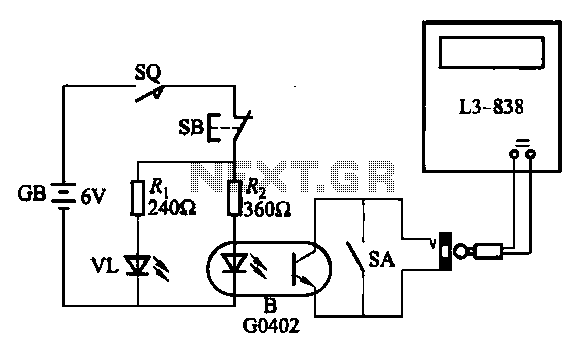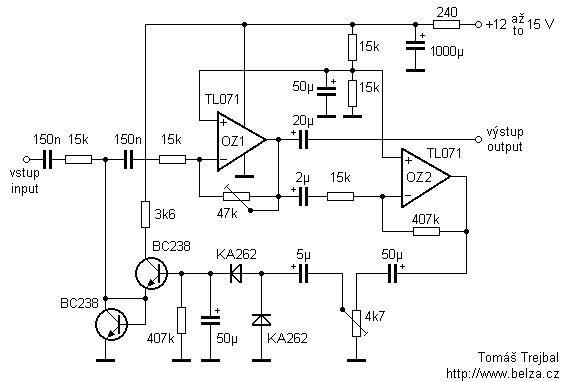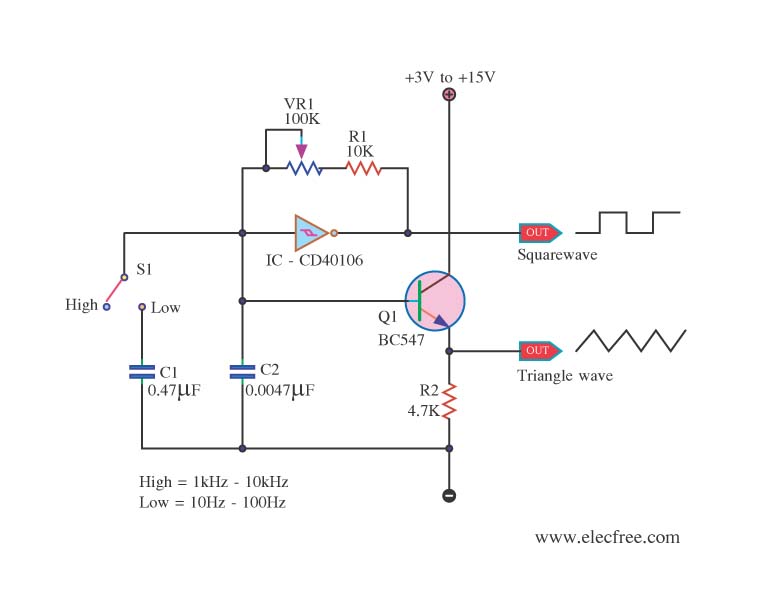
Electronic counter with automatic counting interface circuit a

An electronic calculator features an automatic counting interface circuit, as illustrated in the accompanying figures. Figure (a) depicts a stroke switch controlled via optocoupler B. Figure (b) shows the application of a reed switch (KR) for pulse control signals. Figure (c) demonstrates the use of optocouplers B along with pulse signal control, where LED (VL) is utilized to monitor the operation of counting pulses. Figure (d) illustrates the integration of a photocell (LD) and relay (KA) for control purposes.
The electronic calculator's automatic counting interface circuit is designed to enhance functionality and reliability in counting applications. The stroke switch depicted in Figure (a) serves as an initial input mechanism, enabling user interaction with the system. The optocoupler B acts as an isolator, ensuring that the control signals from the stroke switch do not interfere with the main circuit, thus maintaining signal integrity.
In Figure (b), the reed switch (KR) is employed to generate pulse control signals. This component operates based on magnetic fields, providing a reliable means of detecting the presence of an object or user action, which in turn generates a pulse that can be processed by the calculator's circuitry. The pulse signal is crucial for accurate counting and is transmitted to subsequent components.
Figure (c) illustrates the dual application of optocouplers B, which are utilized alongside the pulse signal control. The LED (VL) serves as a visual indicator, allowing users to monitor the counting pulse operation in real-time. This feature is essential for debugging and ensuring the system operates as intended, providing immediate feedback on the counting process.
Lastly, Figure (d) showcases the use of a photocell (LD) coupled with a relay (KA) for control functions. The photocell detects light levels and can be used to trigger the relay, which in turn activates or deactivates other components within the circuit. This setup allows for automated control based on environmental conditions, enhancing the versatility of the electronic calculator.
Overall, the integration of these components creates a robust and efficient electronic counting system, suitable for various applications that require precise measurement and control. The use of optocouplers, reed switches, LEDs, and photocells ensures that the circuit remains reliable and responsive to user inputs and environmental changes.Electronic calculator with automatic counting of the interface circuit shown in Figure. Figure (a) stroke switch so via optocoupler B control; Fig. (B) the use of reed KR and p ulse control signal; FIG. (C) the use of optocouplers B and pulse signal control, LED VL to monitor counting pulse operation; Fig. (d) the use of photocell LD and relay KA control.
The electronic calculator's automatic counting interface circuit is designed to enhance functionality and reliability in counting applications. The stroke switch depicted in Figure (a) serves as an initial input mechanism, enabling user interaction with the system. The optocoupler B acts as an isolator, ensuring that the control signals from the stroke switch do not interfere with the main circuit, thus maintaining signal integrity.
In Figure (b), the reed switch (KR) is employed to generate pulse control signals. This component operates based on magnetic fields, providing a reliable means of detecting the presence of an object or user action, which in turn generates a pulse that can be processed by the calculator's circuitry. The pulse signal is crucial for accurate counting and is transmitted to subsequent components.
Figure (c) illustrates the dual application of optocouplers B, which are utilized alongside the pulse signal control. The LED (VL) serves as a visual indicator, allowing users to monitor the counting pulse operation in real-time. This feature is essential for debugging and ensuring the system operates as intended, providing immediate feedback on the counting process.
Lastly, Figure (d) showcases the use of a photocell (LD) coupled with a relay (KA) for control functions. The photocell detects light levels and can be used to trigger the relay, which in turn activates or deactivates other components within the circuit. This setup allows for automated control based on environmental conditions, enhancing the versatility of the electronic calculator.
Overall, the integration of these components creates a robust and efficient electronic counting system, suitable for various applications that require precise measurement and control. The use of optocouplers, reed switches, LEDs, and photocells ensures that the circuit remains reliable and responsive to user inputs and environmental changes.Electronic calculator with automatic counting of the interface circuit shown in Figure. Figure (a) stroke switch so via optocoupler B control; Fig. (B) the use of reed KR and p ulse control signal; FIG. (C) the use of optocouplers B and pulse signal control, LED VL to monitor counting pulse operation; Fig. (d) the use of photocell LD and relay KA control.





